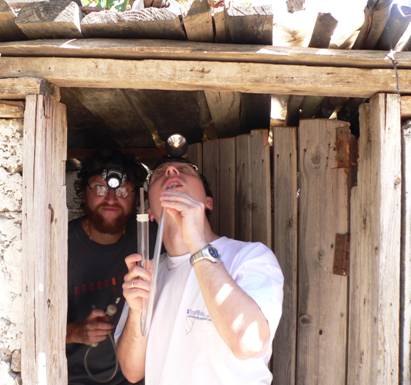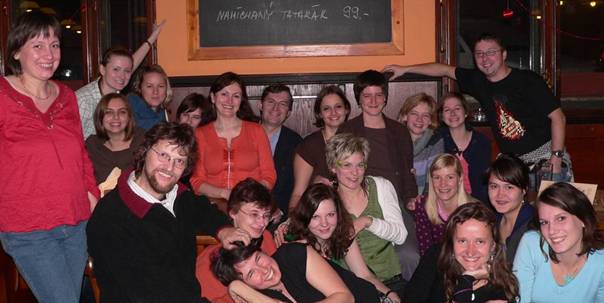Vector Biology Charles University, Czech Republic
The team will is involved in several key aspects of the project. During
the initial operational phase most of our efforts are devoted to field
studies on sand flies in endemic foci in Ethiopia. We are
participating in ecological studies of transmission cycles, sand
fly colonization, sand fly taxonomy, artificial feeding for infection,
development of ELISA assays for determining sero-conversion to sand fly
saliva as a means for assessing the burden of exposure to biting sand
flies and, thereby, the potential for infection with L. donovani.
During subsequent years of the project, we will be actively involved in
design, implementation and monitoring of transmission dynamics and
ecology of sand fly populations densities and species composition as
well as human sero-conversion to sand fly saliva.
Studies
on sand fly ecology will comprise several tasks. Sand flies in the VL
foci will be trapped by several methods in order to study their
occurrence, seasonality, feeding and breeding site preferences and Leishmania infection rate. Caught females will be checked for presence of Leishmania promastigotes by dissection and later by PCR (k-DNA, ITS-1) methods. Isolated Leishmania
strains will be cultivated and inoculated into appropriate
mammalian hosts. All sand fly collection sites together with patient
cases will be registered in GIS databases and compared with selected
environmental features; such analysis and compilation of the data will
bring knowledge about spatial distribution and spacing of vectors and
will facilitate identification of risk factors.
The existence of sibling species, population differences and intraspecific variability of P. orientalis and
other putative vectors will be tested using several molecular methods
(ITS and cyt b haplotype analysis, RAPD analysis and panels of
microsatellite markers) and morphological method (geometric
morphometric analysis). Biological relevance of analyzed molecular
differences will be evaluated by a cross-mating study, enabled by
establishment of laboratory colonies.
Colonies of P. orientalis from several leishmaniasis foci over Ethiopia (and eventually those of other putative vectors, P. martini and P. celiae)
will be established in order to complete the whole transmission cycle
under laboratory conditions. Experimental infections will be used for
evaluation of vector competence of different sand fly populations;
localization of parasites and Leishmania morphotypes in sand
fly gut will be recorded, the intensity of experimental
infections will be compared by Q-PCR and optical microscopy.
Studies
of exposure to sand fly bites will pursue the development of sensitive
and specific ELISA test based on human (and/or animal) antibodies
against sand fly saliva. We would like to know if the antibody response
correlates with numbers of sand flies inside houses and how long
antibodies persist after sand fly season under natural conditions of
exposure. Anti-saliva antibodies could be used also as a risk marker of
Leishmania transmission. A positive association between the
level of IgG antibodies against vector sand fly saliva and the
probability of developing leishmaniasis (CL) has been documented in
humans. In the Old World, no similar study has been done for the
visceral form of disease. Detecting of anti-P. orientalis saliva antibodies in human serum samples will also allow us to associate the level of host exposure with the status of Leishmania donovani infection (measured by rk39 dip stick and other methods). Leishmania
seroconversion of local people will be monitored continuously and
anamnesis will be ascertained using questionnaires. In addition, study
on anti-saliva antibodies will serve to evaluate intervention trials
and control programmes against sand flies. It will improve our
understanding of infectious disease epidemiology and may serve as a
model for future studies on other vector-host combinations.
Personnel
- Petr Volf, Group leader and Co-Principal Investigator volf@cesnet.cz
- Jan Votypka, Co-Principal Investigator vapid@natur.cuni.cz
- Milena Svobodova Associate Researcher milena@natur.cuni.cz
- Vit Dvorak, Associate Researcher icejumper@seznam.cz
Petr Volf’s Vector Biology group is at the Department of Parasitology in Charles University Prague. His group has been studying vector-parasite-host interactions with an emphasis on sand fly-Leishmania, for many years
Selected Publications
- Drahota J., Lipoldova M., Volf P., Rohousova I. Specificity of anti-saliva immune response in mice repeatedly bitten by Phlebotomus sergenti. Parasite Immunology (2009) 31:766-770
- Sadlova J., Volf P. Peritrophic matrix of Phlebotomus duboscqi and its kinetics during Leishmania major development Cell And Tissue Research (2009) 337: 313-325
- Hostomska
J., Volfova V., Mu JB, Garfield M, Rohousova I, Volf P, Valenzuela JG,
Jochim RC Analysis of salivary transcripts and antigens of the sand fly
Phlebotomus arabicus BMC Genomics (2009) 10: 282
- Jecna
L., Svarovska A., Besteiro S., Mottram JC, Coombs GH, Volf P Inhibitor
of Cysteine Peptidase Does Not Influence the Development of Leishmania
mexicana in Lutzomyia longipalpis. Journal Of Medical Entomology (2009) 46: 605-609
- Svobodova
M., Alten B., Zidkova L., Dvorak V., Hlavackova J., Myskova J., Seblova
V., Kasap O. E., Belen A., Votypka J., Volf P. (2009) Cutaneous
leishmaniasis caused by Leishmania infantum transmitted by Phlebotomus
tobbi. International Journal for Parasitology 39: 251–256.
- Volf P, Myskova J. Sand flies and Leishmania: specific versus permissive vectors. Trends Parasitol. (2007) 23:91-2.
- Myskova
J., Svobodova M., Beverley S. M. , Volf P. A
lipophosphoglycan-independent development of Leishmania in permissive
sand flies. Microbes Infect. (2007) 9: 317-24
- Volf
P, Benkova I, Myskova J, Sadlova J, Campino L, Ravel C. Increased
transmission potential of Leishmania major/Leishmania infantum hybrids.
Int J Parasitol. (2007) 37:589-93.
- Benkova I, Volf P. Effect of temperature on metabolism of Phlebotomus papatasi (Diptera: Psychodidae). J Med Entomol.(2007) 44:150-4.
- Svobodova
M, Volf P, Votypka J. (2006) Experimental transmission of Leishmania
tropica to hyraxes (Procavia capensis) by the bite of Phlebotomus
arabicus. Microbes Infect. (2006) 8:1691-4
- Havelkova
H, Badalova J, Svobodova M, Vojtiskova J, Kurey I, Vladimirov V, Demant
P, Lipoldova M. (2006) Genetics of susceptibility to leishmaniasis in
mice: four novel loci and functional heterogeneity of gene effects. Genes Immun. 7: 220-33.
- Svobodova
M., Votypka J., Peckova J., Dvorak V., Nasereddin A., Baneth G., Sztern
J., Kravchenko V., Orr A., Meir D., Schnur L. F., Volf P., Warburg A.
(2006) Distinct Transmission Cycles of Leishmania tropica in 2 Adjacent
Foci, Northern Israel. Emerging Infectious Diseases 12: 1860-8
- Dvorak
V, Aytekin AM, Alten B, Skarupova S, Votypka J, Volf P. A comparison of
the intraspecific variability of Phlebotomus sergenti Parrot, 1917
(Diptera: Psychodidae). J Vector Ecol. (2006) 31:229-38.
- Rohousova I, Volf P. Sand fly saliva: effects on host immune response and Leishmania transmission. Folia Parasitol (Praha). (2006) 53161-71. Review.
- Kato
H, Anderson JM, Kamhawi S, Oliveira F, Lawyer PG, Pham VM, Sangare CS,
Samake S, Sissoko I, Garfield M, Sigutova L, Volf P, Doumbia S,
Valenzuela JG. High degree of conservancy among secreted salivary gland
proteins from two geographically distant Phlebotomus duboscqi sandflies
populations (Mali and Kenya). BMC Genomics. (2006) 7:226.
- Rohousova
I., Ozensoy S., Ozbel Y., Volf P. (2005) Detection of species-specific
antibody response of humans and mice bitten by sand flies. Parasitology 130: 443-449
- Rohousova
I., Volf P., and Lipoldova M. (2005) Modulation of murine cellular
immune response and cytokine production by salivary gland lysate of
three sand fly species. Parasite Immunology 27: 469-473
- Thiakaki
M., Rohousova I., Volfova V., Volf P., Chang K.P., and Soteriadou K.,
(2005) Sand fly species-specificity of saliva-mediated protective
immunity in Leishmania amazonensis-BALB/c mouse model. Microbes and
Infection 7: 760-766
- Hajmova
M., Chang K.P., Kolli B., Volf P. (2004) Down-regulation of gp63 in
Leishmania amazonensis reduces its early development in Lutzomyia
longipalpis. Microbes and Infection 6: 646-649
- Volf
P., Hajmova M., Sadlova J., Votypka J. (2004) Blocked stomodeal valve
of the insect vector: similar mechanism of tranmsission in two
trypanosomatid models. Int. J. Parasitol. 34: 1221-1227
- Soares
R.P.P., Barron T., McKoy-Simandle K., Svobodova M., Warburg A., Turco
S.J. (2004) Leishmania tropica: intraspecific polymorphisms in
lipophosphoglycan correlate with transmission by different Phlebotomus
species. Exp. Parasitol. 107: 105-114
- Boulanger
N., Lowenberger D., Volf P., Ursic R., Sigutova L., Sabatier L.,
Svobodova M., Beverley S.M., Spath G., Brun R., Pesson B., Bulet P.
(2004) Characterization of a defensin from tha sand fly Phlebotomus
duboscqi induced by challenge with bacteria or the protozoan parasite
Leishmania major. Infect. Immun. 72: 7140-7146
- Svobodova
M., Sadlova J., Chang K.P. and Volf P. (2003): Spatial distribution and
feeding preferences of Phlebotomus sergenti and P. papatasi sand flies
in cutaneous leishmaniasis focus of Sanliurfa, Turkey. Am. J. Trop.
Med. Hyg. 68: 6-9
- Svobodova
M., Votypka J., Nicolas L., Volf P. (2003) Leishmania tropica in the
black rat (Rattus rattus): persistance and transmission from
asymptomatic host to sand fly vector Phlebotomus sergenti. Microbes and Infection 5: 361-364
- Svobodova
M., Votypka J. (2003) Experimental transmission of Leishmania tropica
to hamsters and mice by the bite of Phlebotomus sergenti. Microbes and Infection 5: 471-474
Jacobson R.L., Eisenberger C., Svobodova M. et al. (2003) Outbreak of
cutaneous leishmaniasis in northern Israel. J. Inf. Dis. 188: 1065-73
- Sadlova J, Hajmova M, Volf P. (2003) Phlebotomus (Adlerius) halepensis vector competence for Leishmania major and Le. tropica. Med. Vet. Entomol. 17: 244-250
- Depaquit
J., Ferte H., Leger N., Lefranc F., Alves-Pirez C., Hanafi H., Maroli
M., Morillas-Marquez F., Rioux J.A., Svobodova M. and Volf P.(2002):
ITS2 sequences heterogeneity in Phlebotomus sergenti and P. similis:
possible consequences in their ability to transmit Leishmania tropica. Int. J. Parasitol. 32: 1123-1131.
- Lipoldova
M., Svobodova M., Havelkova H., Krulova M., Badalova J., Nohynkov? E.,
Hurt A.A.M., Schlegel D., Volf P. and Demant P. (2002): Mouse genetic
model for clinical and immunological heterogeneity of leishmaniasis. Immunogenetics 54: 174-183.
- Badalova
J., Svobodova M., Havelkova H., Vladimirov V., Vojtiskova J., Engova
J., Pilcik T., Volf P., Demant P. and Lipoldova M. (2002): Separation
and mapping genes that control IgE level in Leishmania major infected
mice. Genes and Immunity 3: 183-195.
- Votypka
J., Obornik M., Volf P., Svobodova M. and Lukes J. (2002): Trypanosoma
avium of raptors (Falconiformes): phylogeny and identification of
vectors. Parasitology 125: 253-263.
- Volf P., Skarupova S. and Man P. (2002): Characterization of the lectin from females of Phlebotomus duboscqi sand flies. Eur. J. Biochem. 269: 6294-6301.
- Volf P., Rohousova I. (2001): Species-specific antigens in salivary glands of phlebotomine sandflies. Parasitology 122: 37-41.
- Volf
P., Svobodova M. and Dvorakova E. (2001): Bloodmeal digestion and
Leishmania major infections in Phlebotomus duboscqi: effect of
carbohydrates inhibiting midgut lectin activity. Med. Vet. Entomol. 15: 281-286.
- Volf
P., Ozbel Y., Akkafa F., Svobodova M., Votypka J. and Chang K.P.
(2001): Sand flies (Diptera: Phlebotominae) in Sanliurfa, Turkey:
relationship of Phlebotomus sergenti with the epidemic of anthroponotic
cutaneous leishmaniasis. J. Med.Entomol.39:12-15.
- Volf P., Tesarova P., Nohynkova E. (2000): Salivary proteins and glycoproteins in sandflies of various species, sex and age. Medical and Veterinary Entomology 14: 251-256.

Vit Dvorak (front) and Jan Votypka collecting sand flies inside a house in Turkey

Members of petr Volf’s Laboratory (Milena Svobodova [standing
front-left]; Jan Votypka [sitting front row -left], Petr Volf [sitting
back row-center], Vit Dvorak [standing back row-right]
|











